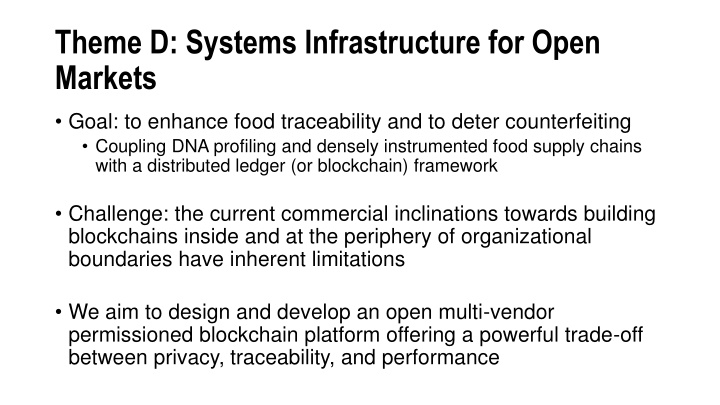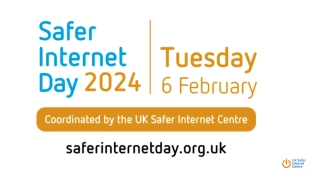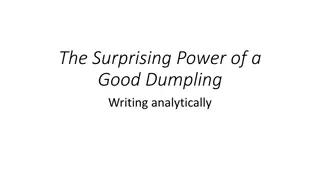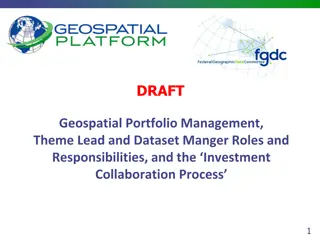
Enhancing Food Traceability with Multi-Vendor Blockchain Platform
Explore the innovative use of DNA profiling and blockchain technology to enhance food traceability and combat counterfeiting in open markets. Learn about the technical challenges and the proposed multi-vendor permissioned blockchain platform for a powerful trade-off between privacy, traceability, and performance.
Download Presentation

Please find below an Image/Link to download the presentation.
The content on the website is provided AS IS for your information and personal use only. It may not be sold, licensed, or shared on other websites without obtaining consent from the author. If you encounter any issues during the download, it is possible that the publisher has removed the file from their server.
You are allowed to download the files provided on this website for personal or commercial use, subject to the condition that they are used lawfully. All files are the property of their respective owners.
The content on the website is provided AS IS for your information and personal use only. It may not be sold, licensed, or shared on other websites without obtaining consent from the author.
E N D
Presentation Transcript
Theme D: Systems Infrastructure for Open Markets Goal: to enhance food traceability and to deter counterfeiting Coupling DNA profiling and densely instrumented food supply chains with a distributed ledger (or blockchain) framework Challenge: the current commercial inclinations towards building blockchains inside and at the periphery of organizational boundaries have inherent limitations We aim to design and develop an open multi-vendor permissioned blockchain platform offering a powerful trade-off between privacy, traceability, and performance
Technical Challenges The key technical challenges in accomplishing overall goal are: Blockchains can mitigate, but do not entirely solve the problem of uniquely associating identities to assets Multi-vendor blockchain information should not be ubiquitously accessible across the platforms and should be protected from competitors Employing generic privacy solutions can be prohibitively expensive
Technical Challenges Possible Counterfeit Opportunity
Technical Approach (1 of 3) Our approach to these problems is: multi-vendor permissioned blockchain platform Permissionless Blockchain Permissioned Blockchain Anyone can join, read, write, and govern (validate, commit, and regulate) Only authorized participant can join, read, and write Functions as an overlay network over the Internet Only a selected few govern (validate) Proof of work, stake, etc. to deal with Sybil attacks Employ strong identity and requires n-party consensus protocols (BFT, Libra) Slow, Low Scalability Fast, High Scalability
Technical Approach (1 of 3) The Execute-Order-Validate approach + Endorsement policies of Hyperledger Fabric is ideally suited for the problem Scalability Control over the write ops
Technical Approach (2 of 3) Understanding privacy, access control requirements Kroger will like to make sure that an item with same id was not transferred to Walmart
Technical Approach (3 of 3) Realizing achieve those using cryptographic and distributed computing techniques Secure Multi-party Computation (MPC) Non-collusion assumption Covert adversary Non-interactive Zero-knowledge proofs (of knowledge) (NIZK) One-wayness, trapdoor permutation Meta-data hiding communication
Technical Approach (3 of 3) Endorsing nodes performs MPC to validate transactions and create private blockchain writes
Related Research and Novelty of Proposed Approach Federated blockchains / Blockchain for Supply-chains Privacy problems are ignored assuming that blockchainsare not public Privacy issues against competitors/insiders are ignored With all nodes inhouse, the chain manipulations can be possible Current NIZK-based solutions are cryptocurrencies are not suitable for supply-chains Robustness guarantees are not available for the current MPC systems Current meta-data hiding communication solutions such as Tor are not acceptable to the industrial settings
Novelty of Proposed Approach Innovation in the MPC space Asynchronous MPC systems with linear communication complexity Optimizing MPC pre-processing towards making computation constant round Developing combinations of NIZK and MPC operations towards optimizing performance Innovations in the meta-data hiding space Meta-data hiding solutions for the permissioned setting
Theme Outcomes Privacy-preserving Multi-supply-chain Blockchain with applicability beyond food supply-chain Robust, Efficient MPC Protocols and Systems with applicability to secure computation in general Meta-data hiding communication protocols tailored for the consortium scenarios
Interaction With Other Themes Theme A: Utilizing DNA profiling When available, our system will utilize DNA watermarks as stronger IDs Theme B: Supply-chain Optimizations End-to-end traceability, Forward/backward Historical Queries can be highly beneficial towards optimizing supply-chains Theme C: Realizing the virtual payment/incentive system Our blockchain solution will be ideally suited for realizing and experimenting with the incentive mechanism






















